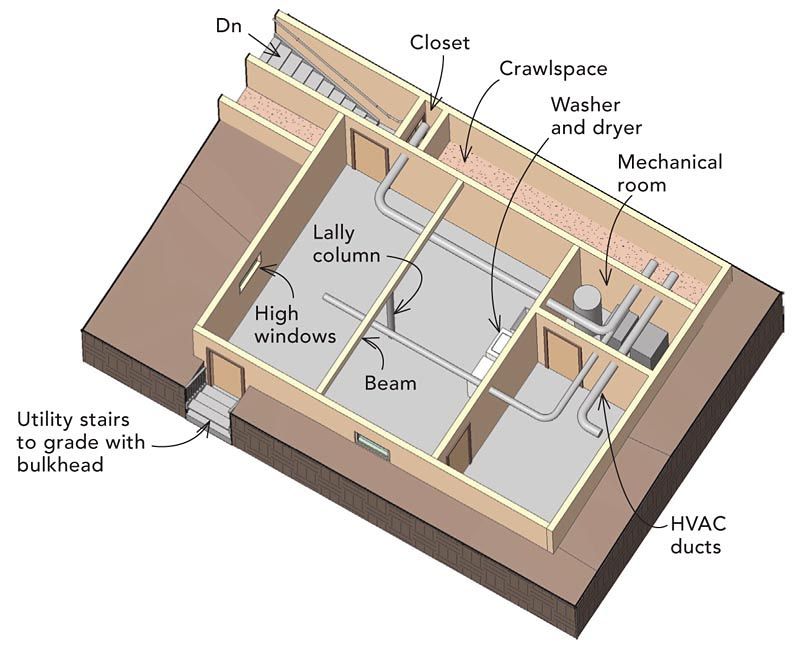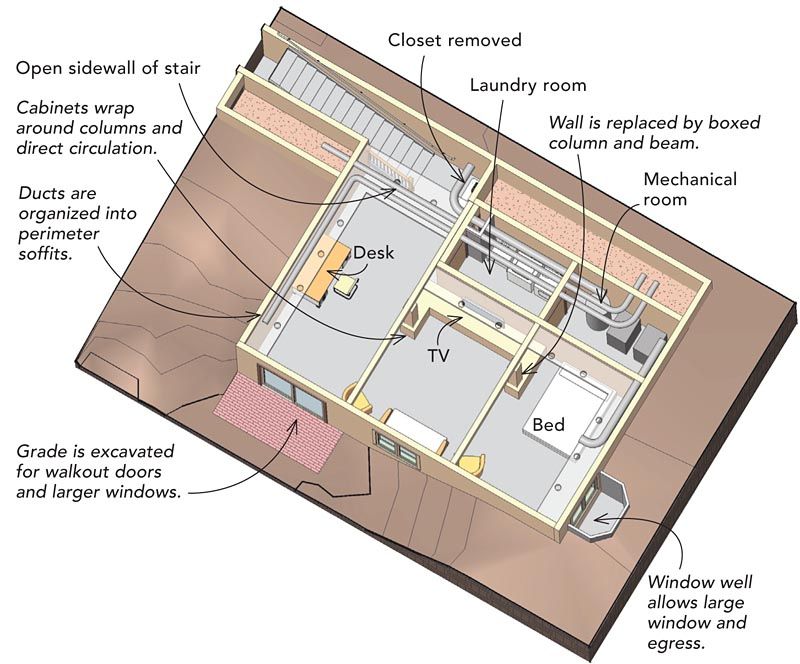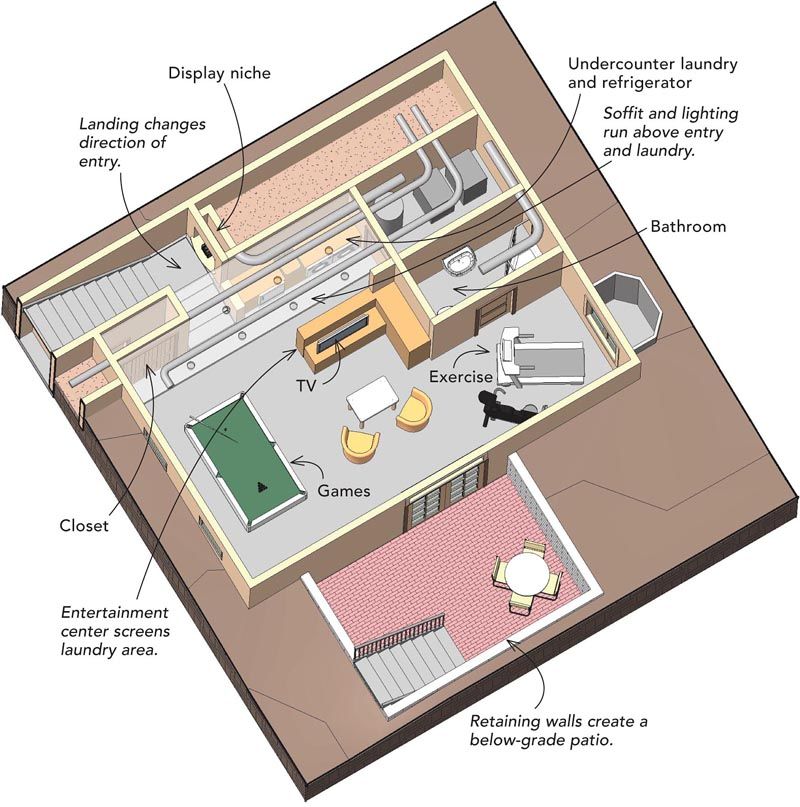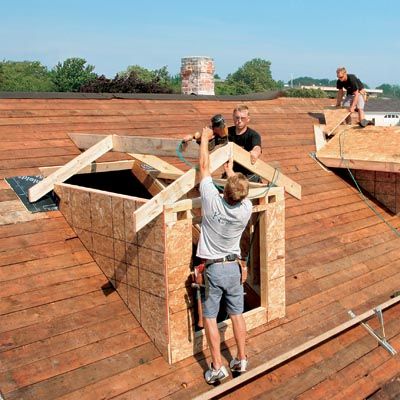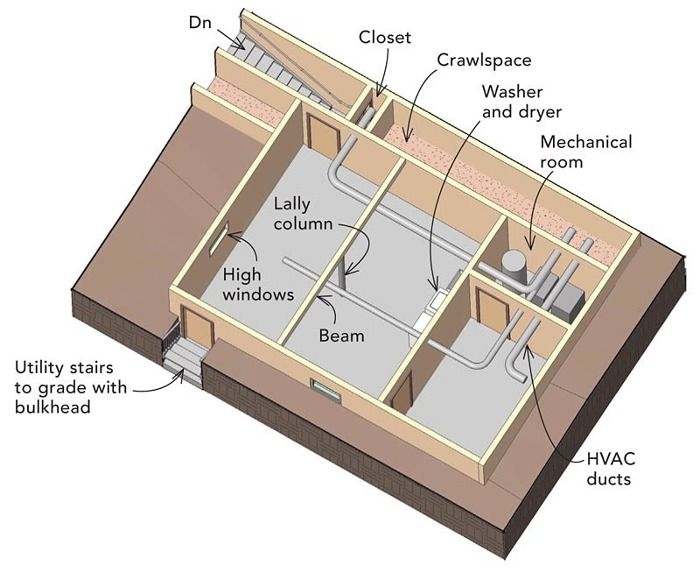
Every time I design a basement room, I think of my cousins’ rec room, where as a kid I spent many of my holidays. This subterranean wonderland was a place of freedom.
Now I design basements for a variety of uses, ranging from playful recreation rooms to hardworking home offices to serene in-law suites. Although finishing a basement doesn’t usually affect a home’s exterior, these stealth additions do transform the lives that exist inside a home.
In some ways, a basement can be treated differently from the rest of the house. A traditional house can have a modern basement, or a quiet household can have a basement music studio.
In other ways, the basement should be treated the same way as the rest of the house. When a basement is finished with as much care and detail as the house above, the message is that the space is an equal part of the home, not subordinate to it.
Basement stairs should be inviting
The stairway to a finished basement should create a comfortable transition to the new room. To me, inviting means stairs that are open to the main house, just as stairs to a second floor would be. Forgoing doors at the top and bottom of the stairwell connects the basement naturally to the main living space.
If you need to separate the basement from the main level with a door (to help contain noise, for instance), don’t default to a plain door. I prefer to use a door that has some glass because it improves the sense of space by giving a hint of what’s beyond. Whatever style that you decide to use, the door should be high quality and interesting.
To ensure a welcoming descent, start with generous dimensions. It’s worth stealing a little space from the floor plan to give the stairs a minimum width of 3 ft. 6 in. and a minimum headroom of 7 ft. Except for rare occasions, such as a wine cellar, when the design deliberately resembles a descent into a cave, the stairs should not wind and twist awkwardly. Use a high-quality railing to indicate that the basement room is part of the living area, not a utility space.
At the bottom, you don’t want the stairs to end 3 ft. from a blank wall or door as many basement stairs do. Rather, plan a graceful transition into a room or hall. If you have a “dead-end” stair, adding a landing that redirects the last few steps into the room takes the focus off the wall at the bottom. You also can provide spatial relief by opening a sidewall along the stairs. When the stairs must take you through tight or awkward spaces, exploit a feeling of compression and release with a bright, open space below.
Add plenty of light
The prevalence of natural and artificial light determines how we experience a room. Light plays an amplified role in the basement because we are already, if subconsciously, battling claustrophobia.
For artificial light, recessed cans work well because they do not intrude on headroom, and LED lights can be snaked into locations with limited clearance. I use dimmable halogen lighting to create a warm glow and often put these fixtures in wall niches or above doorways to introduce a sense of drama and to create a focal point.
High windows above the exterior grade offer natural light and, occasionally, a view toward the sky. Excavating a lightwell provides room for larger basement windows and brings the sills down to a comfortable, human scale. (It also can satisfy the egress requirement for bedrooms.) On rare occasions, natural light can enter via a skylight made of thick safety glass in the floor of the living space above. In the best of circumstances, excavate the grade for walkout glass doors to the yard, changing the basement from an inside destination to a circulation route.
Create views for an open feeling
Outward views depend on the grade around the house, but creating interior vistas by removing walls or punching openings through them increases the sense of openness and space. Use partial walls and half-walls to conceal utilities and essential structural elements while merging spaces into a larger room. Even something as simple as boxing out the foundation with a nice display ledge can make a room feel bigger and more interesting because there are more surfaces to engage the eye and the brain.
When there’s an adjacent crawlspace, one of my favorite tricks is to recess a wall niche into the crawlspace. This design is easy and inexpensive, and it enlarges the room without increasing the footprint.
Varying headroom is also effective. When mechanicals dictate that one area of the basement have a low ceiling, opening a sightline to an area with a higher ceiling lends a sense of height to the lower area.
| Headroom is a problem in unfinished basements |
This unfinished basement has exposed ducts, structural supports, mechanicals, and limited light. Creating a finished room requires hiding or improving each of these elements. The following examples show how I used the space differently for a guest room and a game room.
 |
| Turn obstacles into design features |
In this guest room, the plumbing and ductwork were gathered around the perimeter of the basement and boxed into a soffit, where recessed fixtures cast a curtain of light around the edge of the space. Another great alternative is to relocate them to a conditioned crawlspace. Integrate box beams and wrap Lally columns to turn them into design features. Here, a built-in entertainment center directs foot traffic away from the columns and distracts from their structural role. A TV can also hide a low-hanging beam above it by drawing the eye back down.
 |
| Frame interior views for a sense of space |
Creating longer views in the basement adds the perception of space. For this game room, I’ve used three strategies to make the space feel larger. Borrowing a little area from an adjacent crawlspace at the bottom of the stairs creates room for a display niche that not only makes the landing feel a bit larger but also enhances the transition between the main floor and the basement. The soffit at the bottom of the stairs also compresses the entry, creating a sense of release when entering the other parts of the room.
 |
Because a game room doesn’t require the privacy of a guest room, the laundry area is screened with a half-wall. The longer view and lighting behind the TV lend depth to the rest of the room.
Finally, adding exterior windows and doors is comforting both for views and for natural light. Even without a view, the window well not only lets in more light, but by bringing the sill closer to the floor, it also mitigates the sense of being underground that high windows tend to reinforce.
The bathroom makes the basement an independent level in the home. It also opens up other possibilities, such as a dog-washing area or a changing room for a nearby pool.
—Kurt Lavenson (www.lavensondesign.com) is an architect in Oakland, Calif.
Fine Homebuilding Recommended Products
Fine Homebuilding receives a commission for items purchased through links on this site, including Amazon Associates and other affiliate advertising programs.

All New Kitchen Ideas that Work

Pretty Good House

Homebody: A Guide to Creating Spaces You Never Want to Leave
